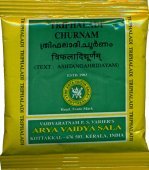Triphaladi, Triphala-adi, Triphalādi: 2 definitions
Introduction:
Triphaladi means something in Hinduism, Sanskrit. If you want to know the exact meaning, history, etymology or English translation of this term then check out the descriptions on this page. Add your comment or reference to a book if you want to contribute to this summary article.
In Hinduism
Ayurveda (science of life)
Kalpa (Formulas, Drug prescriptions and other Medicinal preparations)
Source: Shodhganga: Edition translation and critical study of yogasarasamgraha1) Triphalādi refers to a medicinal recipe mentioned in the Kaṣāyakhaṇḍa (verse 1.84) of the 15th-century Yogasārasaṅgraha (Yogasara-saṅgraha) by Vāsudeva: an unpublished Keralite work representing an Ayurvedic compendium of medicinal recipes. The Kaṣāyakhaṇḍa [mentioning triphalādi] deals with decoctions (kaṣāya) and gruels (peyas) administered to patients suffering from a variety of conditions (viz., alcoholism, vomiting, syncope, burning sensations, etc.).
2) Triphalādi refers to a medicinal recipe mentioned in the Tailakhaṇḍa (verse 3.165) of the 15th-century Yogasārasaṅgraha (Yogasara-saṅgraha) by Vāsudeva: an unpublished Keralite work representing an Ayurvedic compendium of medicinal recipes. The Tailakhaṇḍa [mentioning triphalādi] contains recipes and medicated oils (taila) that treat the patients on such conditions as fever, dyspnoea, cough, asthma, etc.
3) Triphalādi refers to a medicinal recipe mentioned in the Lepakhaṇḍa (verse 4.41) of the 15th-century Yogasārasaṅgraha (Yogasara-saṅgraha) by Vāsudeva: an unpublished Keralite work representing an Ayurvedic compendium of medicinal recipes. The Lepakhaṇḍa [mentioning triphalādi] contains recipes according to circumstances as advised by tradition. They treat the patient suffering from conditions such as fever, piles, emaciation, anorexia, tuberculosis, diarrhea, etc.
4) Triphalādi refers to a medicinal recipe mentioned in the Cūrṇakhaṇḍa (verse 6.83) of the 15th-century Yogasārasaṅgraha (Yogasara-saṅgraha) by Vāsudeva: an unpublished Keralite work representing an Ayurvedic compendium of medicinal recipes. The Cūrṇakhaṇḍa [mentioning triphalādi] contains powdered recipes and treat patients suffering from conditions such as erysipelas, excessive thirst, fever, burning sensation, gonorrhoea, etc.
Unclassified Ayurveda definitions
Source: archive.org: Sushruta samhita, Volume IThe drugs known as
- Haritaki,
-
Āmlaki
- and Vibhitaka,
constitute the group known as the Triphalādi Gana.
The present group destroys the action of the deranged Vāyu, Kapham and Pittam and proves curative in Meha, and in diseases of the skin (Kushtham). It is a good appetiser, improves the eyesight and proves beneficial in chronic intermittent fever (Vishama-jvara).

Āyurveda (आयुर्वेद, ayurveda) is a branch of Indian science dealing with medicine, herbalism, taxology, anatomy, surgery, alchemy and related topics. Traditional practice of Āyurveda in ancient India dates back to at least the first millenium BC. Literature is commonly written in Sanskrit using various poetic metres.
See also (Relevant definitions)
Partial matches: Adi, Triphala.
Ends with: Trikatutriphaladi.
Relevant text
Search found 3 books and stories containing Triphaladi, Triphala-adi, Triphalā-ādi, Triphalādi; (plurals include: Triphaladis, adis, ādis, Triphalādis). You can also click to the full overview containing English textual excerpts. Below are direct links for the most relevant articles:
Rasa Jala Nidhi, vol 3: Metals, Gems and other substances (by Bhudeb Mookerjee)
Part 5 - Purification of iron < [Chapter IV - Metals (4): Lauha (iron)]
Part 6 - Incineration of iron (1-25) < [Chapter IV - Metals (4): Lauha (iron)]
Part 7 - Incineration of iron (26) < [Chapter IV - Metals (4): Lauha (iron)]
Sushruta Samhita, volume 1: Sutrasthana (by Kaviraj Kunja Lal Bhishagratna)
Sushruta Samhita, volume 4: Cikitsasthana (by Kaviraj Kunja Lal Bhishagratna)
Related products




